Strategic Business Plan Report: ASD Sports Trading Company, London
VerifiedAdded on 2023/01/19
|22
|6910
|63
Report
AI Summary
This report presents a business plan for ASD, a London-based sports trading company, outlining its strategies for market expansion and profit growth over the next three years. ASD specializes in sports equipment like skateboards, inline skates, ice hockey sticks, and tennis rackets, sourced from established suppliers. The plan focuses on market development and promoting eco-friendly products. The report analyzes ASD's market position using the BCG Matrix, highlighting the competitive nature of the market and the potential of its various product lines. It also covers sales and marketing strategies, emphasizing the importance of STP analysis for effective customer targeting and positioning. A VRIO analysis identifies ASD's core competencies, with return on equity being a key strength, while addressing weaknesses such as cost management and quality control. The report also includes a group peer review form, reflecting on teamwork dynamics and areas for improvement.

ORGANISATIONAL
CONTEXT
CONTEXT
Paraphrase This Document
Need a fresh take? Get an instant paraphrase of this document with our AI Paraphraser
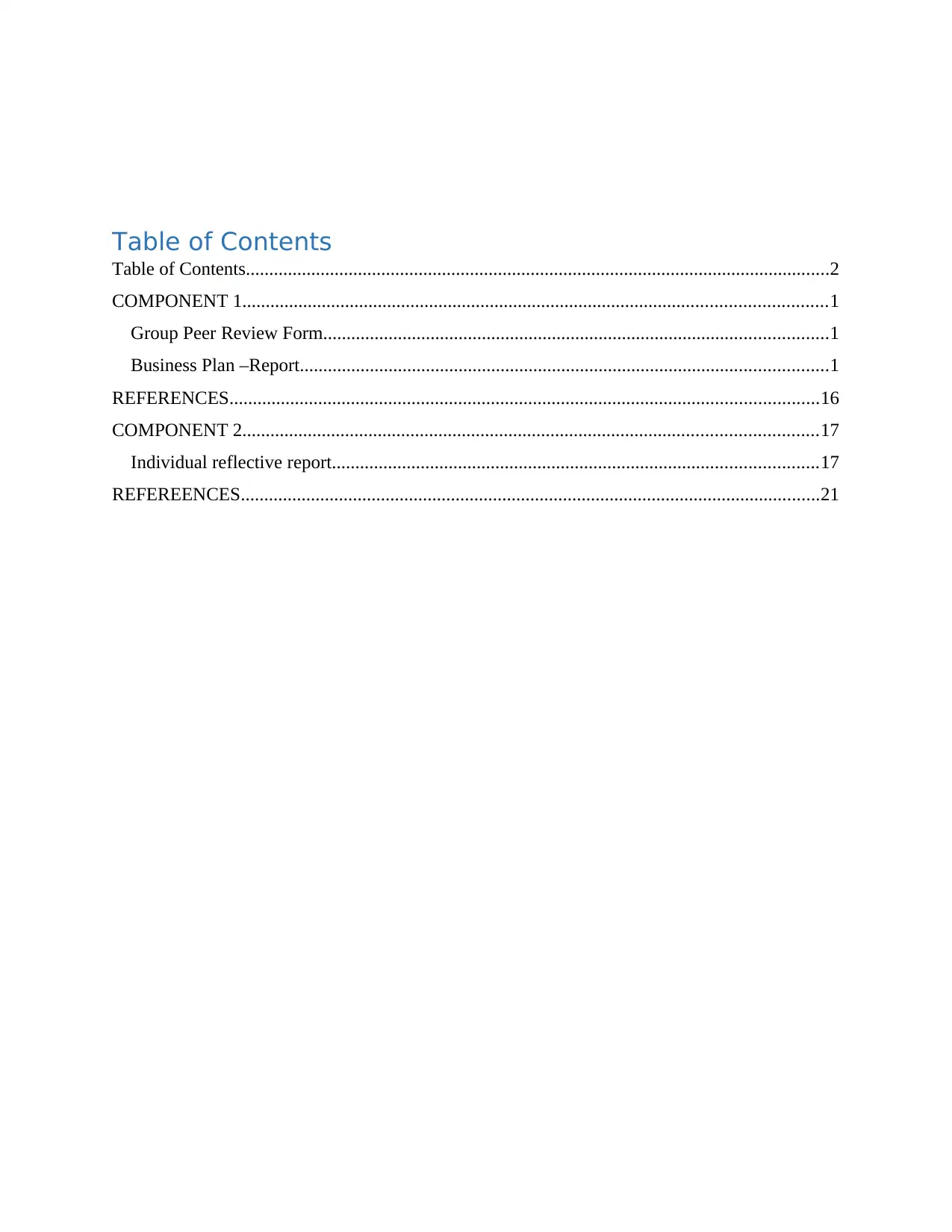
Table of Contents
Table of Contents.............................................................................................................................2
COMPONENT 1.............................................................................................................................1
Group Peer Review Form............................................................................................................1
Business Plan –Report.................................................................................................................1
REFERENCES..............................................................................................................................16
COMPONENT 2...........................................................................................................................17
Individual reflective report........................................................................................................17
REFEREENCES............................................................................................................................21
Table of Contents.............................................................................................................................2
COMPONENT 1.............................................................................................................................1
Group Peer Review Form............................................................................................................1
Business Plan –Report.................................................................................................................1
REFERENCES..............................................................................................................................16
COMPONENT 2...........................................................................................................................17
Individual reflective report........................................................................................................17
REFEREENCES............................................................................................................................21
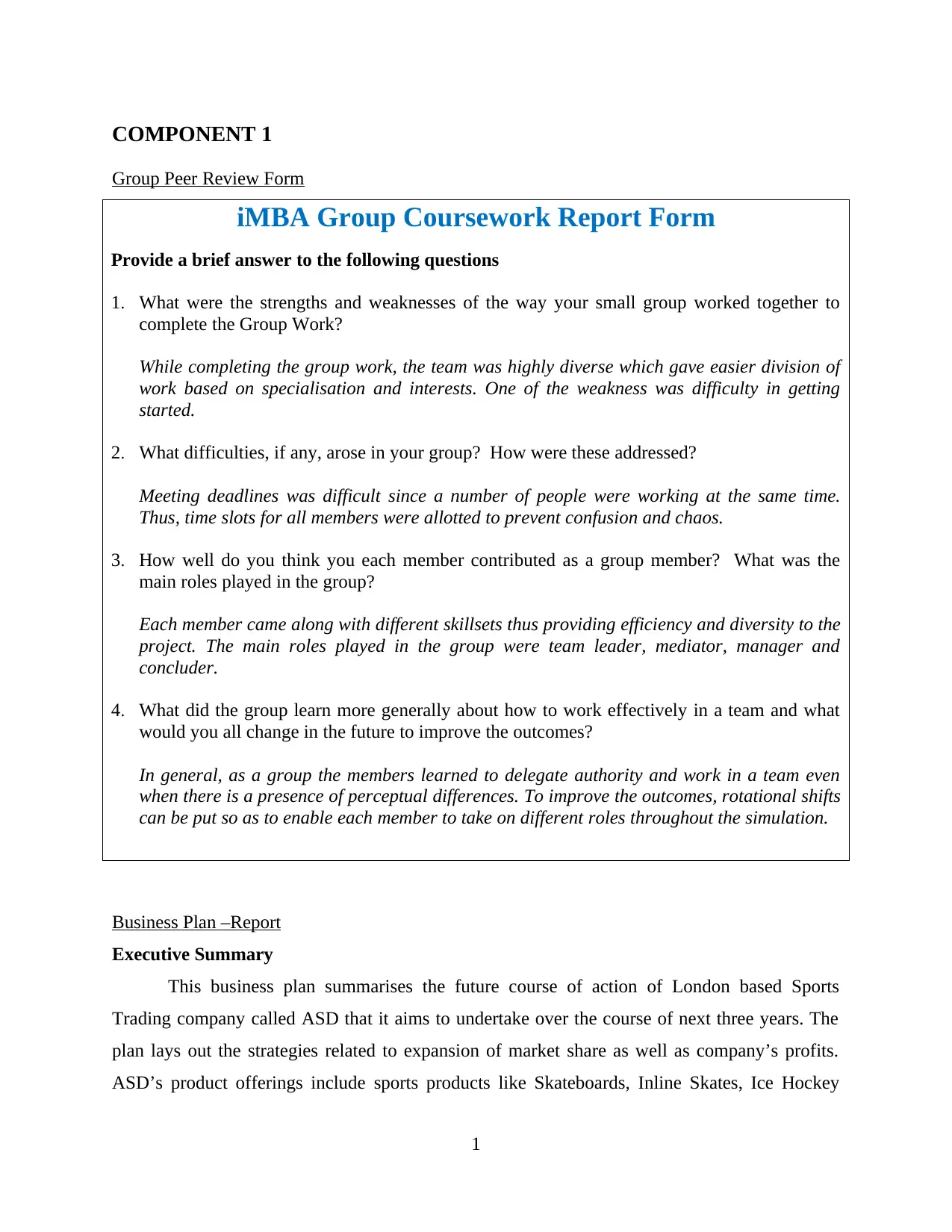
COMPONENT 1
Group Peer Review Form
iMBA Group Coursework Report Form
Provide a brief answer to the following questions
1. What were the strengths and weaknesses of the way your small group worked together to
complete the Group Work?
While completing the group work, the team was highly diverse which gave easier division of
work based on specialisation and interests. One of the weakness was difficulty in getting
started.
2. What difficulties, if any, arose in your group? How were these addressed?
Meeting deadlines was difficult since a number of people were working at the same time.
Thus, time slots for all members were allotted to prevent confusion and chaos.
3. How well do you think you each member contributed as a group member? What was the
main roles played in the group?
Each member came along with different skillsets thus providing efficiency and diversity to the
project. The main roles played in the group were team leader, mediator, manager and
concluder.
4. What did the group learn more generally about how to work effectively in a team and what
would you all change in the future to improve the outcomes?
In general, as a group the members learned to delegate authority and work in a team even
when there is a presence of perceptual differences. To improve the outcomes, rotational shifts
can be put so as to enable each member to take on different roles throughout the simulation.
Business Plan –Report
Executive Summary
This business plan summarises the future course of action of London based Sports
Trading company called ASD that it aims to undertake over the course of next three years. The
plan lays out the strategies related to expansion of market share as well as company’s profits.
ASD’s product offerings include sports products like Skateboards, Inline Skates, Ice Hockey
1
Group Peer Review Form
iMBA Group Coursework Report Form
Provide a brief answer to the following questions
1. What were the strengths and weaknesses of the way your small group worked together to
complete the Group Work?
While completing the group work, the team was highly diverse which gave easier division of
work based on specialisation and interests. One of the weakness was difficulty in getting
started.
2. What difficulties, if any, arose in your group? How were these addressed?
Meeting deadlines was difficult since a number of people were working at the same time.
Thus, time slots for all members were allotted to prevent confusion and chaos.
3. How well do you think you each member contributed as a group member? What was the
main roles played in the group?
Each member came along with different skillsets thus providing efficiency and diversity to the
project. The main roles played in the group were team leader, mediator, manager and
concluder.
4. What did the group learn more generally about how to work effectively in a team and what
would you all change in the future to improve the outcomes?
In general, as a group the members learned to delegate authority and work in a team even
when there is a presence of perceptual differences. To improve the outcomes, rotational shifts
can be put so as to enable each member to take on different roles throughout the simulation.
Business Plan –Report
Executive Summary
This business plan summarises the future course of action of London based Sports
Trading company called ASD that it aims to undertake over the course of next three years. The
plan lays out the strategies related to expansion of market share as well as company’s profits.
ASD’s product offerings include sports products like Skateboards, Inline Skates, Ice Hockey
1
⊘ This is a preview!⊘
Do you want full access?
Subscribe today to unlock all pages.

Trusted by 1+ million students worldwide
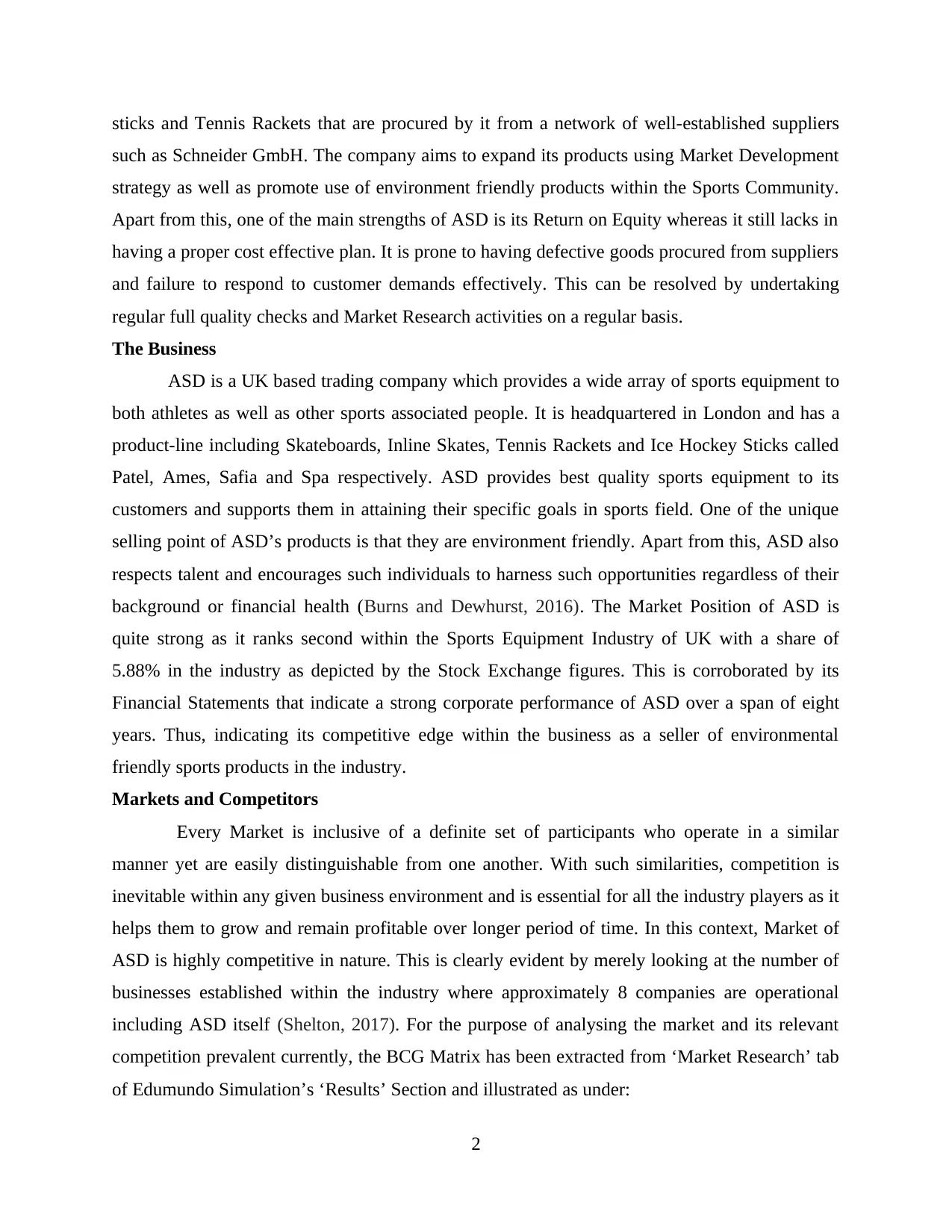
sticks and Tennis Rackets that are procured by it from a network of well-established suppliers
such as Schneider GmbH. The company aims to expand its products using Market Development
strategy as well as promote use of environment friendly products within the Sports Community.
Apart from this, one of the main strengths of ASD is its Return on Equity whereas it still lacks in
having a proper cost effective plan. It is prone to having defective goods procured from suppliers
and failure to respond to customer demands effectively. This can be resolved by undertaking
regular full quality checks and Market Research activities on a regular basis.
The Business
ASD is a UK based trading company which provides a wide array of sports equipment to
both athletes as well as other sports associated people. It is headquartered in London and has a
product-line including Skateboards, Inline Skates, Tennis Rackets and Ice Hockey Sticks called
Patel, Ames, Safia and Spa respectively. ASD provides best quality sports equipment to its
customers and supports them in attaining their specific goals in sports field. One of the unique
selling point of ASD’s products is that they are environment friendly. Apart from this, ASD also
respects talent and encourages such individuals to harness such opportunities regardless of their
background or financial health (Burns and Dewhurst, 2016). The Market Position of ASD is
quite strong as it ranks second within the Sports Equipment Industry of UK with a share of
5.88% in the industry as depicted by the Stock Exchange figures. This is corroborated by its
Financial Statements that indicate a strong corporate performance of ASD over a span of eight
years. Thus, indicating its competitive edge within the business as a seller of environmental
friendly sports products in the industry.
Markets and Competitors
Every Market is inclusive of a definite set of participants who operate in a similar
manner yet are easily distinguishable from one another. With such similarities, competition is
inevitable within any given business environment and is essential for all the industry players as it
helps them to grow and remain profitable over longer period of time. In this context, Market of
ASD is highly competitive in nature. This is clearly evident by merely looking at the number of
businesses established within the industry where approximately 8 companies are operational
including ASD itself (Shelton, 2017). For the purpose of analysing the market and its relevant
competition prevalent currently, the BCG Matrix has been extracted from ‘Market Research’ tab
of Edumundo Simulation’s ‘Results’ Section and illustrated as under:
2
such as Schneider GmbH. The company aims to expand its products using Market Development
strategy as well as promote use of environment friendly products within the Sports Community.
Apart from this, one of the main strengths of ASD is its Return on Equity whereas it still lacks in
having a proper cost effective plan. It is prone to having defective goods procured from suppliers
and failure to respond to customer demands effectively. This can be resolved by undertaking
regular full quality checks and Market Research activities on a regular basis.
The Business
ASD is a UK based trading company which provides a wide array of sports equipment to
both athletes as well as other sports associated people. It is headquartered in London and has a
product-line including Skateboards, Inline Skates, Tennis Rackets and Ice Hockey Sticks called
Patel, Ames, Safia and Spa respectively. ASD provides best quality sports equipment to its
customers and supports them in attaining their specific goals in sports field. One of the unique
selling point of ASD’s products is that they are environment friendly. Apart from this, ASD also
respects talent and encourages such individuals to harness such opportunities regardless of their
background or financial health (Burns and Dewhurst, 2016). The Market Position of ASD is
quite strong as it ranks second within the Sports Equipment Industry of UK with a share of
5.88% in the industry as depicted by the Stock Exchange figures. This is corroborated by its
Financial Statements that indicate a strong corporate performance of ASD over a span of eight
years. Thus, indicating its competitive edge within the business as a seller of environmental
friendly sports products in the industry.
Markets and Competitors
Every Market is inclusive of a definite set of participants who operate in a similar
manner yet are easily distinguishable from one another. With such similarities, competition is
inevitable within any given business environment and is essential for all the industry players as it
helps them to grow and remain profitable over longer period of time. In this context, Market of
ASD is highly competitive in nature. This is clearly evident by merely looking at the number of
businesses established within the industry where approximately 8 companies are operational
including ASD itself (Shelton, 2017). For the purpose of analysing the market and its relevant
competition prevalent currently, the BCG Matrix has been extracted from ‘Market Research’ tab
of Edumundo Simulation’s ‘Results’ Section and illustrated as under:
2
Paraphrase This Document
Need a fresh take? Get an instant paraphrase of this document with our AI Paraphraser
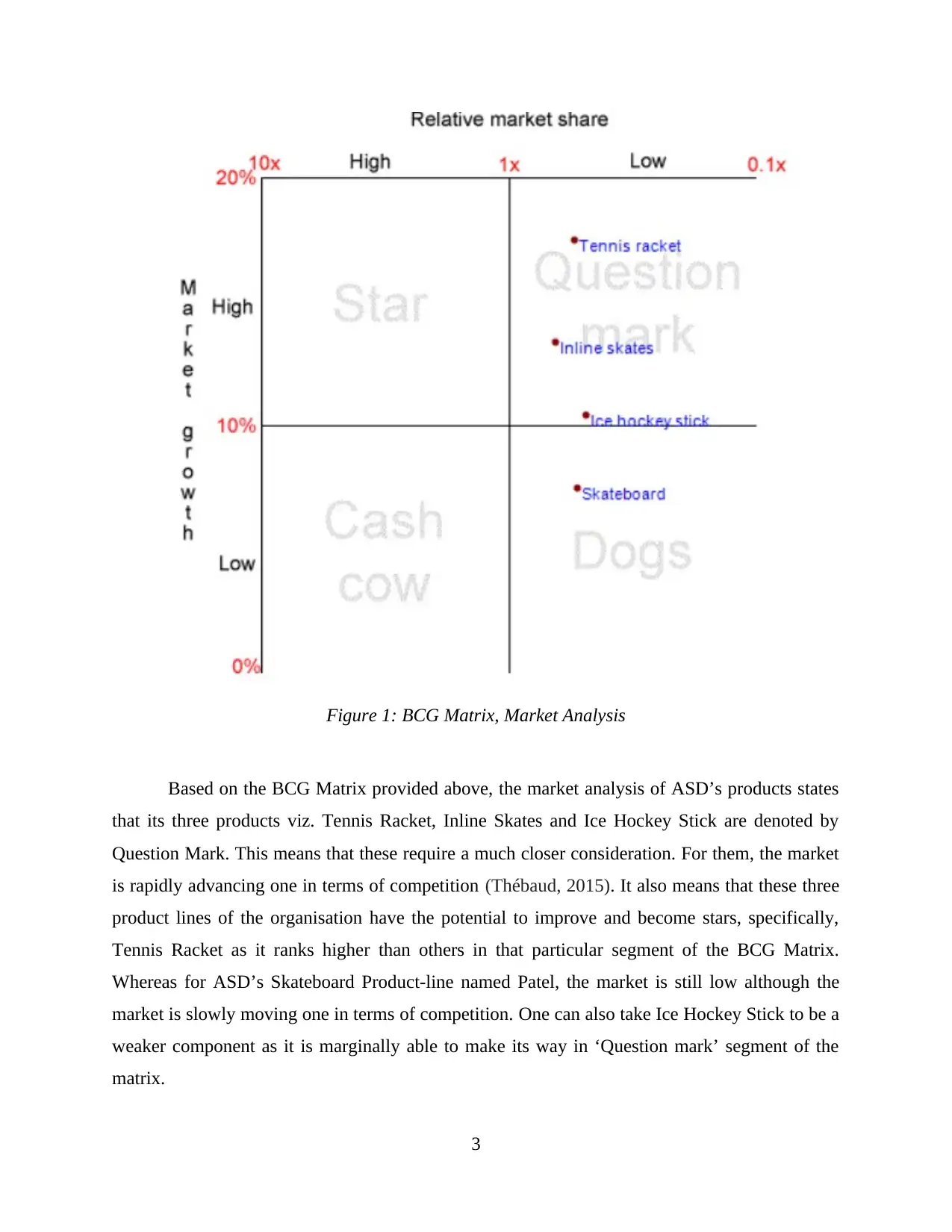
Figure 1: BCG Matrix, Market Analysis
Based on the BCG Matrix provided above, the market analysis of ASD’s products states
that its three products viz. Tennis Racket, Inline Skates and Ice Hockey Stick are denoted by
Question Mark. This means that these require a much closer consideration. For them, the market
is rapidly advancing one in terms of competition (Thébaud, 2015). It also means that these three
product lines of the organisation have the potential to improve and become stars, specifically,
Tennis Racket as it ranks higher than others in that particular segment of the BCG Matrix.
Whereas for ASD’s Skateboard Product-line named Patel, the market is still low although the
market is slowly moving one in terms of competition. One can also take Ice Hockey Stick to be a
weaker component as it is marginally able to make its way in ‘Question mark’ segment of the
matrix.
3
Based on the BCG Matrix provided above, the market analysis of ASD’s products states
that its three products viz. Tennis Racket, Inline Skates and Ice Hockey Stick are denoted by
Question Mark. This means that these require a much closer consideration. For them, the market
is rapidly advancing one in terms of competition (Thébaud, 2015). It also means that these three
product lines of the organisation have the potential to improve and become stars, specifically,
Tennis Racket as it ranks higher than others in that particular segment of the BCG Matrix.
Whereas for ASD’s Skateboard Product-line named Patel, the market is still low although the
market is slowly moving one in terms of competition. One can also take Ice Hockey Stick to be a
weaker component as it is marginally able to make its way in ‘Question mark’ segment of the
matrix.
3
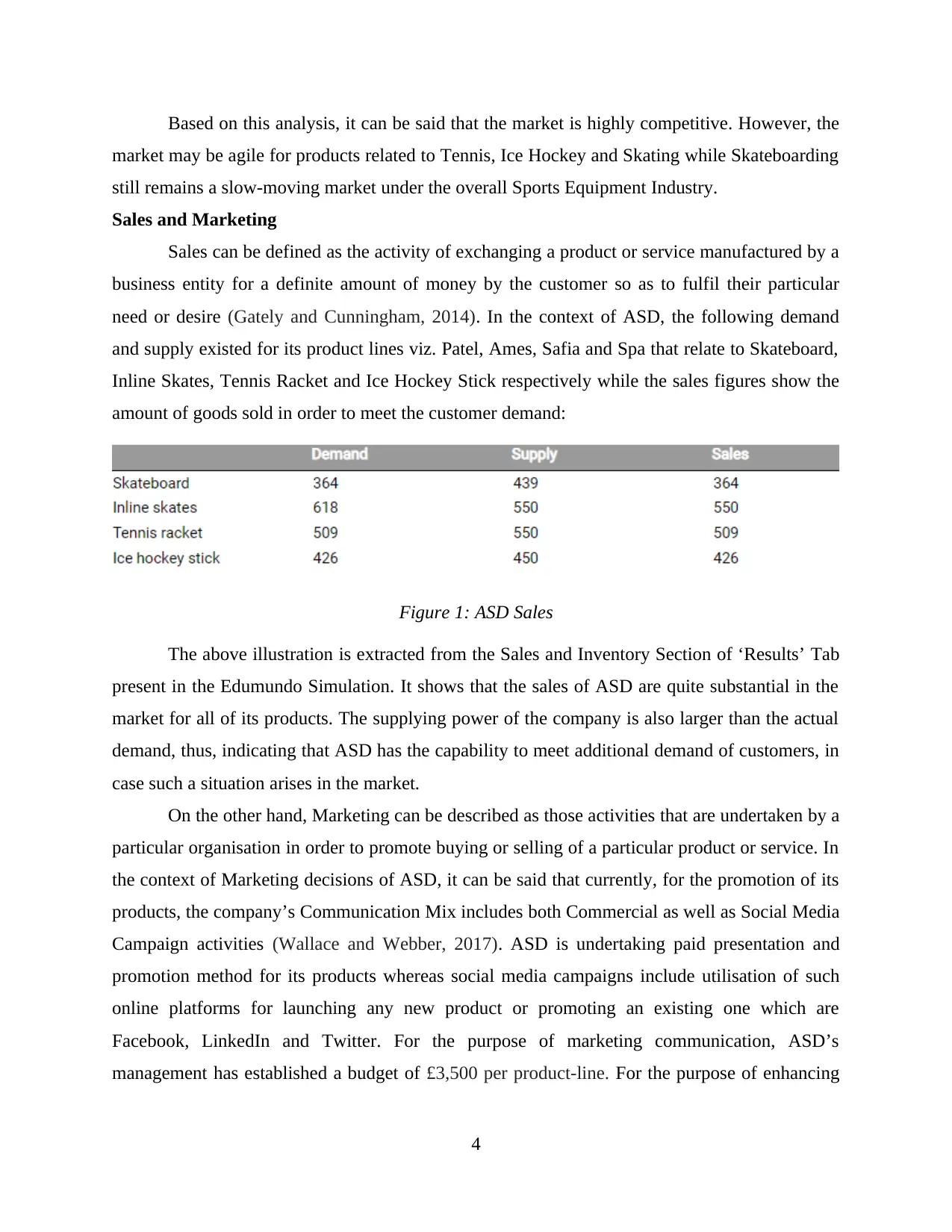
Based on this analysis, it can be said that the market is highly competitive. However, the
market may be agile for products related to Tennis, Ice Hockey and Skating while Skateboarding
still remains a slow-moving market under the overall Sports Equipment Industry.
Sales and Marketing
Sales can be defined as the activity of exchanging a product or service manufactured by a
business entity for a definite amount of money by the customer so as to fulfil their particular
need or desire (Gately and Cunningham, 2014). In the context of ASD, the following demand
and supply existed for its product lines viz. Patel, Ames, Safia and Spa that relate to Skateboard,
Inline Skates, Tennis Racket and Ice Hockey Stick respectively while the sales figures show the
amount of goods sold in order to meet the customer demand:
Figure 1: ASD Sales
The above illustration is extracted from the Sales and Inventory Section of ‘Results’ Tab
present in the Edumundo Simulation. It shows that the sales of ASD are quite substantial in the
market for all of its products. The supplying power of the company is also larger than the actual
demand, thus, indicating that ASD has the capability to meet additional demand of customers, in
case such a situation arises in the market.
On the other hand, Marketing can be described as those activities that are undertaken by a
particular organisation in order to promote buying or selling of a particular product or service. In
the context of Marketing decisions of ASD, it can be said that currently, for the promotion of its
products, the company’s Communication Mix includes both Commercial as well as Social Media
Campaign activities (Wallace and Webber, 2017). ASD is undertaking paid presentation and
promotion method for its products whereas social media campaigns include utilisation of such
online platforms for launching any new product or promoting an existing one which are
Facebook, LinkedIn and Twitter. For the purpose of marketing communication, ASD’s
management has established a budget of £3,500 per product-line. For the purpose of enhancing
4
market may be agile for products related to Tennis, Ice Hockey and Skating while Skateboarding
still remains a slow-moving market under the overall Sports Equipment Industry.
Sales and Marketing
Sales can be defined as the activity of exchanging a product or service manufactured by a
business entity for a definite amount of money by the customer so as to fulfil their particular
need or desire (Gately and Cunningham, 2014). In the context of ASD, the following demand
and supply existed for its product lines viz. Patel, Ames, Safia and Spa that relate to Skateboard,
Inline Skates, Tennis Racket and Ice Hockey Stick respectively while the sales figures show the
amount of goods sold in order to meet the customer demand:
Figure 1: ASD Sales
The above illustration is extracted from the Sales and Inventory Section of ‘Results’ Tab
present in the Edumundo Simulation. It shows that the sales of ASD are quite substantial in the
market for all of its products. The supplying power of the company is also larger than the actual
demand, thus, indicating that ASD has the capability to meet additional demand of customers, in
case such a situation arises in the market.
On the other hand, Marketing can be described as those activities that are undertaken by a
particular organisation in order to promote buying or selling of a particular product or service. In
the context of Marketing decisions of ASD, it can be said that currently, for the promotion of its
products, the company’s Communication Mix includes both Commercial as well as Social Media
Campaign activities (Wallace and Webber, 2017). ASD is undertaking paid presentation and
promotion method for its products whereas social media campaigns include utilisation of such
online platforms for launching any new product or promoting an existing one which are
Facebook, LinkedIn and Twitter. For the purpose of marketing communication, ASD’s
management has established a budget of £3,500 per product-line. For the purpose of enhancing
4
⊘ This is a preview!⊘
Do you want full access?
Subscribe today to unlock all pages.

Trusted by 1+ million students worldwide

its market share and fight competition effectively, ASD must undertake STP analysis so as to get
a better picture regarding its customer base. This has been explained as under:
Segmentation: As the name suggests, this step of STP Analysis includes the division of
prospective customers into groups of people that share a common set of traits or
characteristics. Essentially, these have been enumerated and analysed as under:
o Geographical: Based on the location of customers, ASD needs to divide its market
so as to know which regions showcase higher demand for its product. This will
enable the business to identify its regional demand in an effective manner which
can further be used for strategy formulation purposes for distinct geographical
markets (Camilleri, 2018).
o Demographical: Segmenting the customers based on Demographics includes
dividing the client base on the basis of age, population, gender and income among
others. For instance, ASD can divide its market based on gender wherein
customers aged between 13 to 30 with an income level of less than £1,000 but
more than £450 per month. Target: This step includes the process of selecting potential customers that exhibit similar
characteristics and are most likely to buy the product offerings of the organisation. In
context of ASD, the target market includes both professional and non-professional
athletes as well as sports lovers, specifically involved in Skateboarding, Ice Hockey,
Skating and Tennis.
Position: This can be defined as the process of positioning company’s brand from
customer’s perspective. In order to become the premium choice of customers, ASD needs
to ensure that its existing as well as prospective customers have a good image,
specifically, one which shows environment friendliness (Schlegelmilch, 2016).
While undertaking marketing activities, ASD would be able to cater to its customer needs in
a much clearer and effective manner. Thus, guiding company management to select right
market segment so as to enable correct and efficient positioning of the product offerings in
the mind of its target market.
Management
Management is an important function of a business organisation. Failure to effectively
manage different functions of the business may cause an enterprise to incur losses or even shut
5
a better picture regarding its customer base. This has been explained as under:
Segmentation: As the name suggests, this step of STP Analysis includes the division of
prospective customers into groups of people that share a common set of traits or
characteristics. Essentially, these have been enumerated and analysed as under:
o Geographical: Based on the location of customers, ASD needs to divide its market
so as to know which regions showcase higher demand for its product. This will
enable the business to identify its regional demand in an effective manner which
can further be used for strategy formulation purposes for distinct geographical
markets (Camilleri, 2018).
o Demographical: Segmenting the customers based on Demographics includes
dividing the client base on the basis of age, population, gender and income among
others. For instance, ASD can divide its market based on gender wherein
customers aged between 13 to 30 with an income level of less than £1,000 but
more than £450 per month. Target: This step includes the process of selecting potential customers that exhibit similar
characteristics and are most likely to buy the product offerings of the organisation. In
context of ASD, the target market includes both professional and non-professional
athletes as well as sports lovers, specifically involved in Skateboarding, Ice Hockey,
Skating and Tennis.
Position: This can be defined as the process of positioning company’s brand from
customer’s perspective. In order to become the premium choice of customers, ASD needs
to ensure that its existing as well as prospective customers have a good image,
specifically, one which shows environment friendliness (Schlegelmilch, 2016).
While undertaking marketing activities, ASD would be able to cater to its customer needs in
a much clearer and effective manner. Thus, guiding company management to select right
market segment so as to enable correct and efficient positioning of the product offerings in
the mind of its target market.
Management
Management is an important function of a business organisation. Failure to effectively
manage different functions of the business may cause an enterprise to incur losses or even shut
5
Paraphrase This Document
Need a fresh take? Get an instant paraphrase of this document with our AI Paraphraser

down due to mismanagement. In order to manage ASD’s business activities in an effective
manner, it is important for the manager to carry out a comprehensive analysis of its resources.
For this purpose, VRIO Analysis has been employed so as to identify ASD’s current
competencies. This framework enables the manager to recognise various competencies based on
four critical touchpoints viz. Value (V), Rarity (R), Inimitability (I) and Organisation-Wide
Support (O) (Knott, 2015). Such an analysis has been discussed as under:
Resources V R I O
Cost Effectiveness ✔
Strong Market Presence ✔ ✔
Technological Development ✔ ✔ ✔
Return on Equity ✔ ✔ ✔ ✔
The above table provides a Resource-Based View of ASD. By employing VRIO
Framework, the following competency of ASD has been ascertained: Valuable (V): The company is mostly excelling in four main areas viz. Cost
Effectiveness, Technological Development, Market Growth and Return On Equity. Thus,
these four resources have proven to be valuable for the business as they are contributing
greatly to the overall success of ASD in the Sports Equipment Market. Rarity (R): Cost Effectiveness is not rare for a business as it can be easily attained by
others if they are able to tweak their policies in a manner which results in cost
minimisation. However, other resources such as Technological Development, Strong
Market Presence and Return on Equity are rare as it is difficult to acquire these by ASD’s
Competitors. Inimitable (I): Strong Market Presence is not inimitable for ASD as it can be easily
attained by others once acquired. Since most of the differentiation is based on distinctive
features of the sports products. It is only sensible that every organisation has the potential
to acquire larger market share through effective strategy formulation (Xiaohui and Bin,
2015).
Organised (O): Technological Development is not organised within the company. This is
mostly due to uncertainty surrounding the same. Since this resource is largely dependent
upon the market fluctuations and other external influences.
6
manner, it is important for the manager to carry out a comprehensive analysis of its resources.
For this purpose, VRIO Analysis has been employed so as to identify ASD’s current
competencies. This framework enables the manager to recognise various competencies based on
four critical touchpoints viz. Value (V), Rarity (R), Inimitability (I) and Organisation-Wide
Support (O) (Knott, 2015). Such an analysis has been discussed as under:
Resources V R I O
Cost Effectiveness ✔
Strong Market Presence ✔ ✔
Technological Development ✔ ✔ ✔
Return on Equity ✔ ✔ ✔ ✔
The above table provides a Resource-Based View of ASD. By employing VRIO
Framework, the following competency of ASD has been ascertained: Valuable (V): The company is mostly excelling in four main areas viz. Cost
Effectiveness, Technological Development, Market Growth and Return On Equity. Thus,
these four resources have proven to be valuable for the business as they are contributing
greatly to the overall success of ASD in the Sports Equipment Market. Rarity (R): Cost Effectiveness is not rare for a business as it can be easily attained by
others if they are able to tweak their policies in a manner which results in cost
minimisation. However, other resources such as Technological Development, Strong
Market Presence and Return on Equity are rare as it is difficult to acquire these by ASD’s
Competitors. Inimitable (I): Strong Market Presence is not inimitable for ASD as it can be easily
attained by others once acquired. Since most of the differentiation is based on distinctive
features of the sports products. It is only sensible that every organisation has the potential
to acquire larger market share through effective strategy formulation (Xiaohui and Bin,
2015).
Organised (O): Technological Development is not organised within the company. This is
mostly due to uncertainty surrounding the same. Since this resource is largely dependent
upon the market fluctuations and other external influences.
6
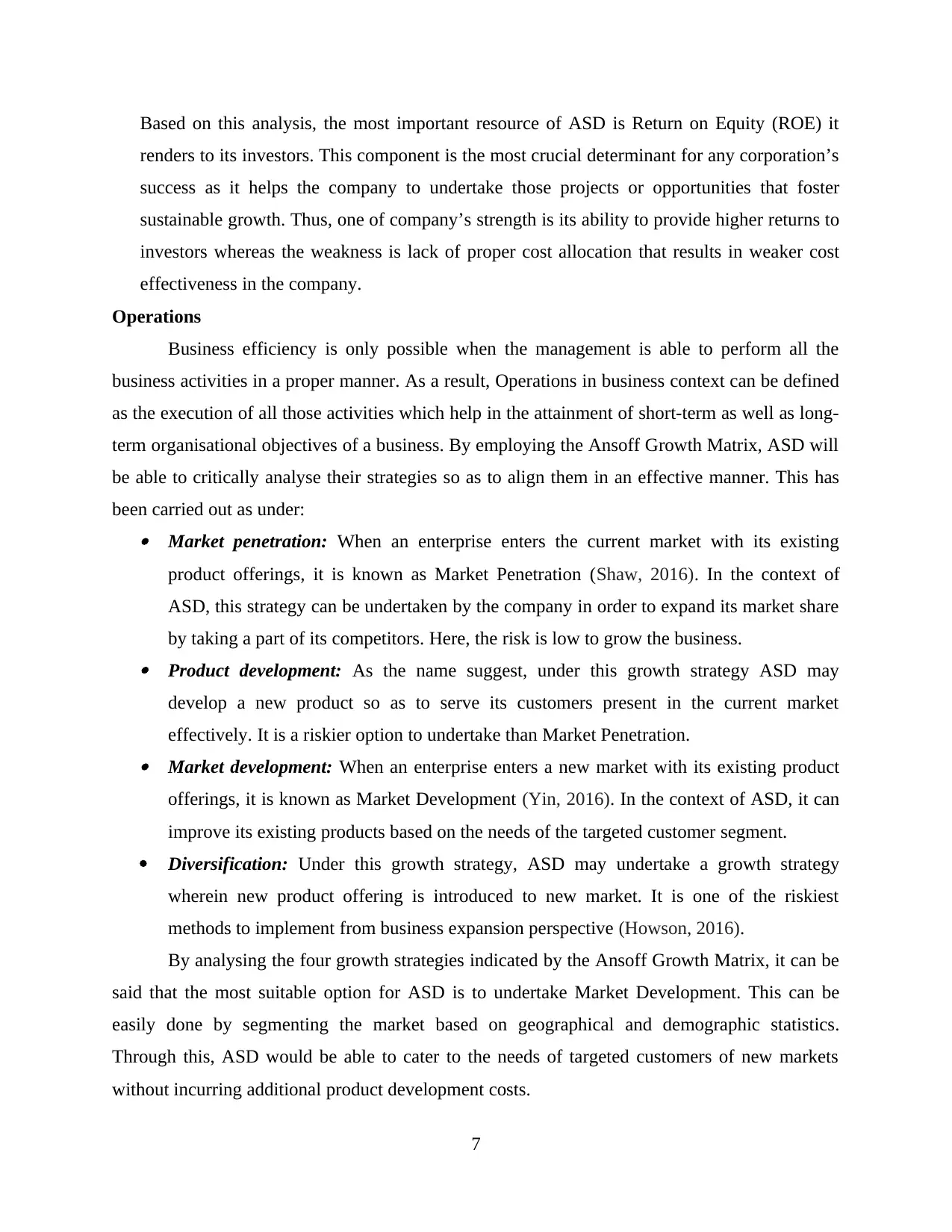
Based on this analysis, the most important resource of ASD is Return on Equity (ROE) it
renders to its investors. This component is the most crucial determinant for any corporation’s
success as it helps the company to undertake those projects or opportunities that foster
sustainable growth. Thus, one of company’s strength is its ability to provide higher returns to
investors whereas the weakness is lack of proper cost allocation that results in weaker cost
effectiveness in the company.
Operations
Business efficiency is only possible when the management is able to perform all the
business activities in a proper manner. As a result, Operations in business context can be defined
as the execution of all those activities which help in the attainment of short-term as well as long-
term organisational objectives of a business. By employing the Ansoff Growth Matrix, ASD will
be able to critically analyse their strategies so as to align them in an effective manner. This has
been carried out as under: Market penetration: When an enterprise enters the current market with its existing
product offerings, it is known as Market Penetration (Shaw, 2016). In the context of
ASD, this strategy can be undertaken by the company in order to expand its market share
by taking a part of its competitors. Here, the risk is low to grow the business. Product development: As the name suggest, under this growth strategy ASD may
develop a new product so as to serve its customers present in the current market
effectively. It is a riskier option to undertake than Market Penetration. Market development: When an enterprise enters a new market with its existing product
offerings, it is known as Market Development (Yin, 2016). In the context of ASD, it can
improve its existing products based on the needs of the targeted customer segment.
Diversification: Under this growth strategy, ASD may undertake a growth strategy
wherein new product offering is introduced to new market. It is one of the riskiest
methods to implement from business expansion perspective (Howson, 2016).
By analysing the four growth strategies indicated by the Ansoff Growth Matrix, it can be
said that the most suitable option for ASD is to undertake Market Development. This can be
easily done by segmenting the market based on geographical and demographic statistics.
Through this, ASD would be able to cater to the needs of targeted customers of new markets
without incurring additional product development costs.
7
renders to its investors. This component is the most crucial determinant for any corporation’s
success as it helps the company to undertake those projects or opportunities that foster
sustainable growth. Thus, one of company’s strength is its ability to provide higher returns to
investors whereas the weakness is lack of proper cost allocation that results in weaker cost
effectiveness in the company.
Operations
Business efficiency is only possible when the management is able to perform all the
business activities in a proper manner. As a result, Operations in business context can be defined
as the execution of all those activities which help in the attainment of short-term as well as long-
term organisational objectives of a business. By employing the Ansoff Growth Matrix, ASD will
be able to critically analyse their strategies so as to align them in an effective manner. This has
been carried out as under: Market penetration: When an enterprise enters the current market with its existing
product offerings, it is known as Market Penetration (Shaw, 2016). In the context of
ASD, this strategy can be undertaken by the company in order to expand its market share
by taking a part of its competitors. Here, the risk is low to grow the business. Product development: As the name suggest, under this growth strategy ASD may
develop a new product so as to serve its customers present in the current market
effectively. It is a riskier option to undertake than Market Penetration. Market development: When an enterprise enters a new market with its existing product
offerings, it is known as Market Development (Yin, 2016). In the context of ASD, it can
improve its existing products based on the needs of the targeted customer segment.
Diversification: Under this growth strategy, ASD may undertake a growth strategy
wherein new product offering is introduced to new market. It is one of the riskiest
methods to implement from business expansion perspective (Howson, 2016).
By analysing the four growth strategies indicated by the Ansoff Growth Matrix, it can be
said that the most suitable option for ASD is to undertake Market Development. This can be
easily done by segmenting the market based on geographical and demographic statistics.
Through this, ASD would be able to cater to the needs of targeted customers of new markets
without incurring additional product development costs.
7
⊘ This is a preview!⊘
Do you want full access?
Subscribe today to unlock all pages.

Trusted by 1+ million students worldwide
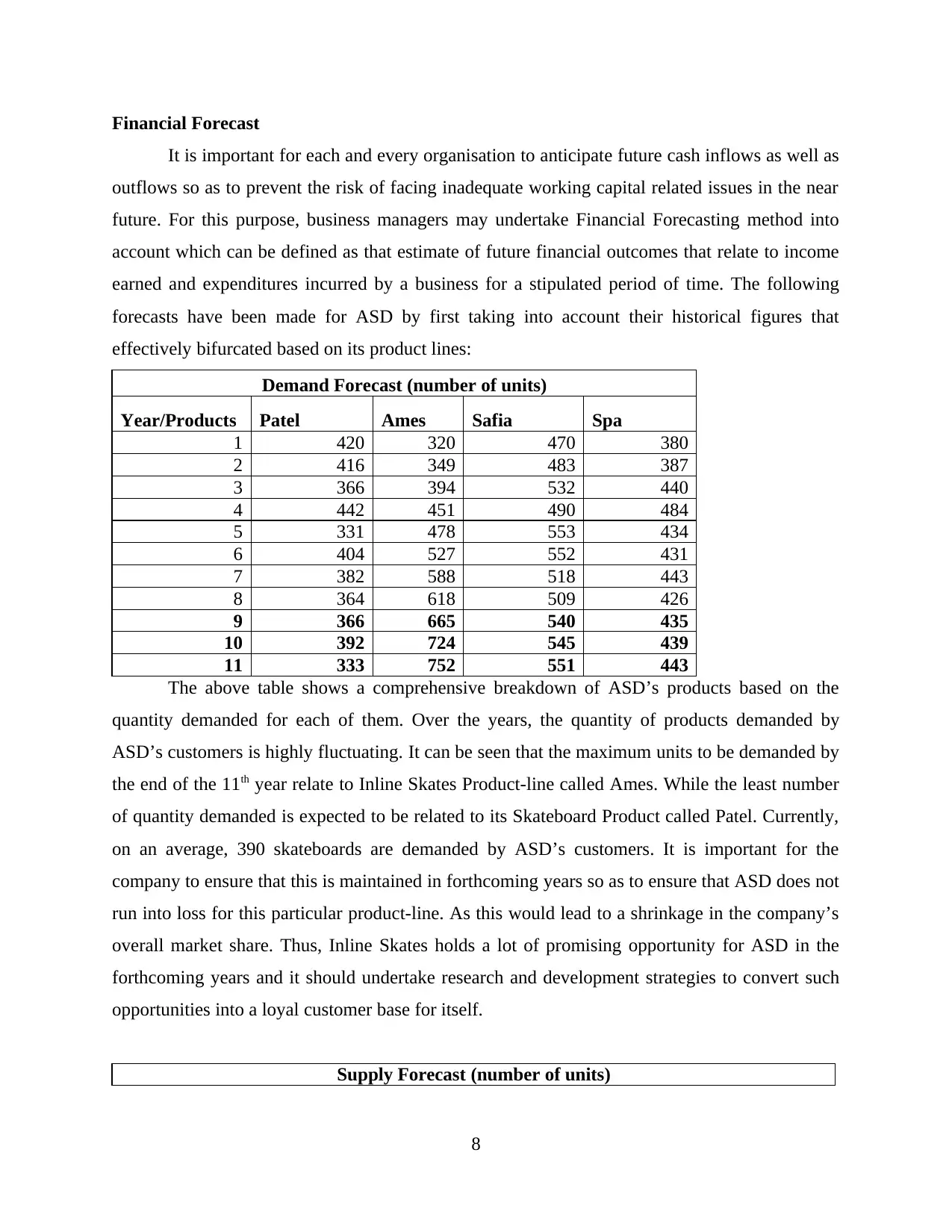
Financial Forecast
It is important for each and every organisation to anticipate future cash inflows as well as
outflows so as to prevent the risk of facing inadequate working capital related issues in the near
future. For this purpose, business managers may undertake Financial Forecasting method into
account which can be defined as that estimate of future financial outcomes that relate to income
earned and expenditures incurred by a business for a stipulated period of time. The following
forecasts have been made for ASD by first taking into account their historical figures that
effectively bifurcated based on its product lines:
Demand Forecast (number of units)
Year/Products Patel Ames Safia Spa
1 420 320 470 380
2 416 349 483 387
3 366 394 532 440
4 442 451 490 484
5 331 478 553 434
6 404 527 552 431
7 382 588 518 443
8 364 618 509 426
9 366 665 540 435
10 392 724 545 439
11 333 752 551 443
The above table shows a comprehensive breakdown of ASD’s products based on the
quantity demanded for each of them. Over the years, the quantity of products demanded by
ASD’s customers is highly fluctuating. It can be seen that the maximum units to be demanded by
the end of the 11th year relate to Inline Skates Product-line called Ames. While the least number
of quantity demanded is expected to be related to its Skateboard Product called Patel. Currently,
on an average, 390 skateboards are demanded by ASD’s customers. It is important for the
company to ensure that this is maintained in forthcoming years so as to ensure that ASD does not
run into loss for this particular product-line. As this would lead to a shrinkage in the company’s
overall market share. Thus, Inline Skates holds a lot of promising opportunity for ASD in the
forthcoming years and it should undertake research and development strategies to convert such
opportunities into a loyal customer base for itself.
Supply Forecast (number of units)
8
It is important for each and every organisation to anticipate future cash inflows as well as
outflows so as to prevent the risk of facing inadequate working capital related issues in the near
future. For this purpose, business managers may undertake Financial Forecasting method into
account which can be defined as that estimate of future financial outcomes that relate to income
earned and expenditures incurred by a business for a stipulated period of time. The following
forecasts have been made for ASD by first taking into account their historical figures that
effectively bifurcated based on its product lines:
Demand Forecast (number of units)
Year/Products Patel Ames Safia Spa
1 420 320 470 380
2 416 349 483 387
3 366 394 532 440
4 442 451 490 484
5 331 478 553 434
6 404 527 552 431
7 382 588 518 443
8 364 618 509 426
9 366 665 540 435
10 392 724 545 439
11 333 752 551 443
The above table shows a comprehensive breakdown of ASD’s products based on the
quantity demanded for each of them. Over the years, the quantity of products demanded by
ASD’s customers is highly fluctuating. It can be seen that the maximum units to be demanded by
the end of the 11th year relate to Inline Skates Product-line called Ames. While the least number
of quantity demanded is expected to be related to its Skateboard Product called Patel. Currently,
on an average, 390 skateboards are demanded by ASD’s customers. It is important for the
company to ensure that this is maintained in forthcoming years so as to ensure that ASD does not
run into loss for this particular product-line. As this would lead to a shrinkage in the company’s
overall market share. Thus, Inline Skates holds a lot of promising opportunity for ASD in the
forthcoming years and it should undertake research and development strategies to convert such
opportunities into a loyal customer base for itself.
Supply Forecast (number of units)
8
Paraphrase This Document
Need a fresh take? Get an instant paraphrase of this document with our AI Paraphraser
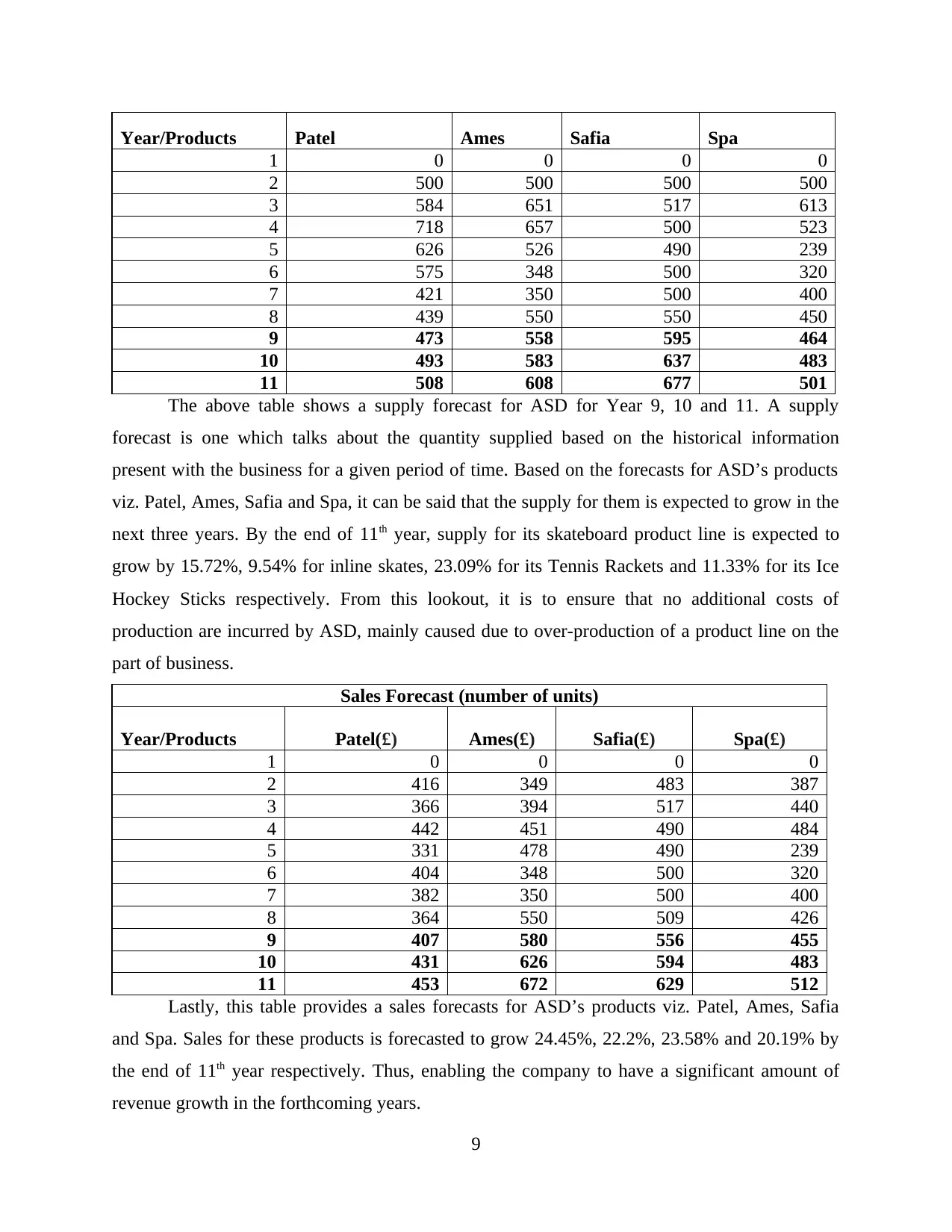
Year/Products Patel Ames Safia Spa
1 0 0 0 0
2 500 500 500 500
3 584 651 517 613
4 718 657 500 523
5 626 526 490 239
6 575 348 500 320
7 421 350 500 400
8 439 550 550 450
9 473 558 595 464
10 493 583 637 483
11 508 608 677 501
The above table shows a supply forecast for ASD for Year 9, 10 and 11. A supply
forecast is one which talks about the quantity supplied based on the historical information
present with the business for a given period of time. Based on the forecasts for ASD’s products
viz. Patel, Ames, Safia and Spa, it can be said that the supply for them is expected to grow in the
next three years. By the end of 11th year, supply for its skateboard product line is expected to
grow by 15.72%, 9.54% for inline skates, 23.09% for its Tennis Rackets and 11.33% for its Ice
Hockey Sticks respectively. From this lookout, it is to ensure that no additional costs of
production are incurred by ASD, mainly caused due to over-production of a product line on the
part of business.
Sales Forecast (number of units)
Year/Products Patel(£) Ames(£) Safia(£) Spa(£)
1 0 0 0 0
2 416 349 483 387
3 366 394 517 440
4 442 451 490 484
5 331 478 490 239
6 404 348 500 320
7 382 350 500 400
8 364 550 509 426
9 407 580 556 455
10 431 626 594 483
11 453 672 629 512
Lastly, this table provides a sales forecasts for ASD’s products viz. Patel, Ames, Safia
and Spa. Sales for these products is forecasted to grow 24.45%, 22.2%, 23.58% and 20.19% by
the end of 11th year respectively. Thus, enabling the company to have a significant amount of
revenue growth in the forthcoming years.
9
1 0 0 0 0
2 500 500 500 500
3 584 651 517 613
4 718 657 500 523
5 626 526 490 239
6 575 348 500 320
7 421 350 500 400
8 439 550 550 450
9 473 558 595 464
10 493 583 637 483
11 508 608 677 501
The above table shows a supply forecast for ASD for Year 9, 10 and 11. A supply
forecast is one which talks about the quantity supplied based on the historical information
present with the business for a given period of time. Based on the forecasts for ASD’s products
viz. Patel, Ames, Safia and Spa, it can be said that the supply for them is expected to grow in the
next three years. By the end of 11th year, supply for its skateboard product line is expected to
grow by 15.72%, 9.54% for inline skates, 23.09% for its Tennis Rackets and 11.33% for its Ice
Hockey Sticks respectively. From this lookout, it is to ensure that no additional costs of
production are incurred by ASD, mainly caused due to over-production of a product line on the
part of business.
Sales Forecast (number of units)
Year/Products Patel(£) Ames(£) Safia(£) Spa(£)
1 0 0 0 0
2 416 349 483 387
3 366 394 517 440
4 442 451 490 484
5 331 478 490 239
6 404 348 500 320
7 382 350 500 400
8 364 550 509 426
9 407 580 556 455
10 431 626 594 483
11 453 672 629 512
Lastly, this table provides a sales forecasts for ASD’s products viz. Patel, Ames, Safia
and Spa. Sales for these products is forecasted to grow 24.45%, 22.2%, 23.58% and 20.19% by
the end of 11th year respectively. Thus, enabling the company to have a significant amount of
revenue growth in the forthcoming years.
9
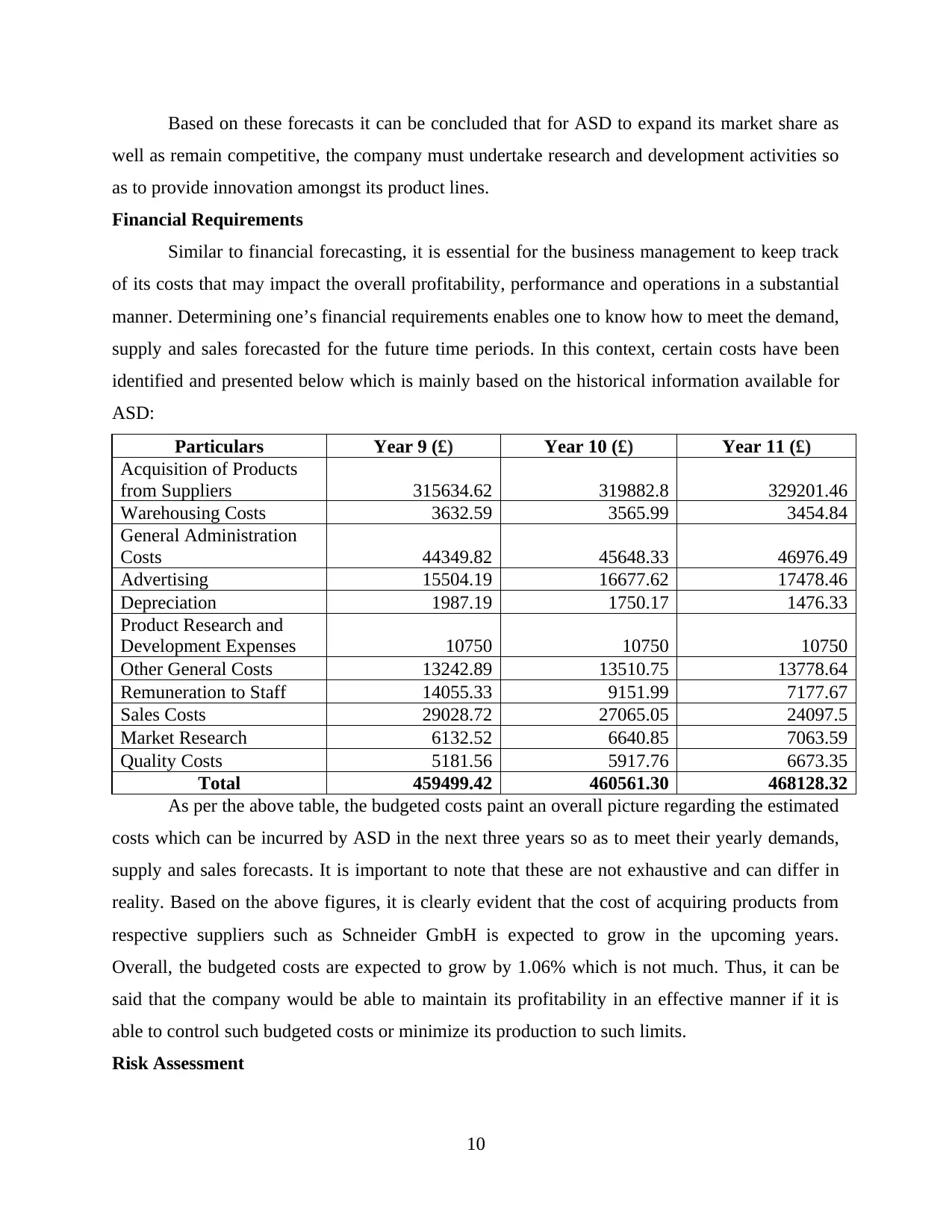
Based on these forecasts it can be concluded that for ASD to expand its market share as
well as remain competitive, the company must undertake research and development activities so
as to provide innovation amongst its product lines.
Financial Requirements
Similar to financial forecasting, it is essential for the business management to keep track
of its costs that may impact the overall profitability, performance and operations in a substantial
manner. Determining one’s financial requirements enables one to know how to meet the demand,
supply and sales forecasted for the future time periods. In this context, certain costs have been
identified and presented below which is mainly based on the historical information available for
ASD:
Particulars Year 9 (£) Year 10 (£) Year 11 (£)
Acquisition of Products
from Suppliers 315634.62 319882.8 329201.46
Warehousing Costs 3632.59 3565.99 3454.84
General Administration
Costs 44349.82 45648.33 46976.49
Advertising 15504.19 16677.62 17478.46
Depreciation 1987.19 1750.17 1476.33
Product Research and
Development Expenses 10750 10750 10750
Other General Costs 13242.89 13510.75 13778.64
Remuneration to Staff 14055.33 9151.99 7177.67
Sales Costs 29028.72 27065.05 24097.5
Market Research 6132.52 6640.85 7063.59
Quality Costs 5181.56 5917.76 6673.35
Total 459499.42 460561.30 468128.32
As per the above table, the budgeted costs paint an overall picture regarding the estimated
costs which can be incurred by ASD in the next three years so as to meet their yearly demands,
supply and sales forecasts. It is important to note that these are not exhaustive and can differ in
reality. Based on the above figures, it is clearly evident that the cost of acquiring products from
respective suppliers such as Schneider GmbH is expected to grow in the upcoming years.
Overall, the budgeted costs are expected to grow by 1.06% which is not much. Thus, it can be
said that the company would be able to maintain its profitability in an effective manner if it is
able to control such budgeted costs or minimize its production to such limits.
Risk Assessment
10
well as remain competitive, the company must undertake research and development activities so
as to provide innovation amongst its product lines.
Financial Requirements
Similar to financial forecasting, it is essential for the business management to keep track
of its costs that may impact the overall profitability, performance and operations in a substantial
manner. Determining one’s financial requirements enables one to know how to meet the demand,
supply and sales forecasted for the future time periods. In this context, certain costs have been
identified and presented below which is mainly based on the historical information available for
ASD:
Particulars Year 9 (£) Year 10 (£) Year 11 (£)
Acquisition of Products
from Suppliers 315634.62 319882.8 329201.46
Warehousing Costs 3632.59 3565.99 3454.84
General Administration
Costs 44349.82 45648.33 46976.49
Advertising 15504.19 16677.62 17478.46
Depreciation 1987.19 1750.17 1476.33
Product Research and
Development Expenses 10750 10750 10750
Other General Costs 13242.89 13510.75 13778.64
Remuneration to Staff 14055.33 9151.99 7177.67
Sales Costs 29028.72 27065.05 24097.5
Market Research 6132.52 6640.85 7063.59
Quality Costs 5181.56 5917.76 6673.35
Total 459499.42 460561.30 468128.32
As per the above table, the budgeted costs paint an overall picture regarding the estimated
costs which can be incurred by ASD in the next three years so as to meet their yearly demands,
supply and sales forecasts. It is important to note that these are not exhaustive and can differ in
reality. Based on the above figures, it is clearly evident that the cost of acquiring products from
respective suppliers such as Schneider GmbH is expected to grow in the upcoming years.
Overall, the budgeted costs are expected to grow by 1.06% which is not much. Thus, it can be
said that the company would be able to maintain its profitability in an effective manner if it is
able to control such budgeted costs or minimize its production to such limits.
Risk Assessment
10
⊘ This is a preview!⊘
Do you want full access?
Subscribe today to unlock all pages.

Trusted by 1+ million students worldwide
1 out of 22
Related Documents
Your All-in-One AI-Powered Toolkit for Academic Success.
+13062052269
info@desklib.com
Available 24*7 on WhatsApp / Email
![[object Object]](/_next/static/media/star-bottom.7253800d.svg)
Unlock your academic potential
Copyright © 2020–2025 A2Z Services. All Rights Reserved. Developed and managed by ZUCOL.





